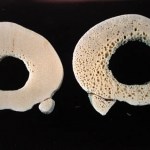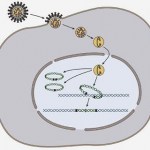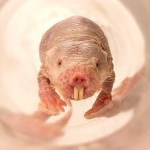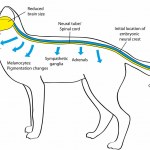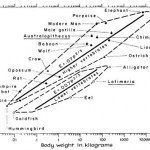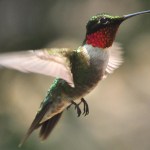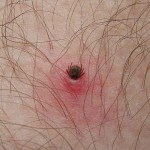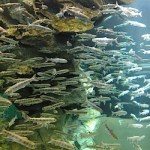Life Sciences
Image from the American Physiological Society's website.http://www.the-aps.org/mm/Conferences/APS-Conferences/2014-Conferences/…
Tuesday was no less exciting than Monday!
Here are some highlights:
I thoroughly enjoyed a session called "Overcoming a Major Physiological Barrier: Adaptation from Saline to Freshwater Habitats" which highlighted the need for several species to shift how they regulate ion balance when they migrate between fresh water (ion absorption from the water) and salt water (ion secretion to the water).
Clements K, Bojarski L, Johnson K, McMillan S, White L, Angert E (Univ…
Image from the American Physiological Society's website.http://www.the-aps.org/mm/Conferences/APS-Conferences/2014-Conferences/…
As anticipated, the meeting today was excellent! Here are some highlights from today:
Dr. Michael Joyner (Mayo Clinic) spoke about how we should reconsider animal models that are used in research as laboratory rodents can be manipulated to match their genotype to their phenotype. In other words, researchers modify the animal's genome to produce a specific disease or attribute they are interested in studying. The problem with this approach is that genes can be…
University of Washington biology professor David Barash published this op-ed in The New York Times recently. The title: “God, Darwin and My College Biology Class.” Intriguing! Let's have a look.
EVERY year around this time, with the college year starting, I give my students The Talk. It isn't, as you might expect, about sex, but about evolution and religion, and how they get along. More to the point, how they don't.
I'm a biologist, in fact an evolutionary biologist, although no biologist, and no biology course, can help being “evolutionary.” My animal behavior class, with 200…
This discussion has been going on for some time, and a handful of recent events have prompted me to jump into it (beyond a simple comment or two). First, I saw a bunch of yammering among various biology teachers about this topic. Then Michael Osterholm wrote a well intentioned but seemingly deeply flawed opinion at the New York Times, then Dina Fine Maron wrote an excellent piece at Scientific American deconstructing Osterholm's piece, then the latter two (and more) were summarized and expanded on in a post by Ann Reid at the NCSE.
Here, I will expand on this by applying first principles…
Image from the American Physiological Society's website.http://www.the-aps.org/mm/Conferences/APS-Conferences/2014-Conferences/…
I am really excited about the comparative physiology conference that starts this weekend in San Diego! Here is a press release about the meeting (author Stacy Brooks from the American Physiological Society):
Bethesda, Md. (September 25, 2014) — More than 400 comparative and evolutionary physiologists will gather to present new research and discoveries in animal physiology at the American Physiological Society’s 2014 intersociety meeting “Comparative…
Depiction of a retrovirus integrating its DNA into the DNA of the host cell. Image from: http://bit.ly/1phzpbR
I read an interesting article in Scientific American that discussed the so-called Peto's Paradox. Dr. Richard Peto (University of Oxford) came up with the idea that if every cell has an equal probability of becoming cancerous, then larger animals would be predicted to develop cancer at higher rates than smaller animals. As it turns out, it is not that simple. All mammals exhibit similar cancer rates, with some exceptions. This is what came to be known as Peto's Paradox.
Some…
Conservationists are trying hard to save the Devils Hole pupfish (Cyprinodon diabolis) from extinction. With less than 100 animals remaining, a captive breeding program was started at the University of California, Berkeley.
As you can imagine from the image below, the geographic range of this fish is smaller than other wild vertebrates. They are only found in the limestone caverns of the geothermal Devils Hole pool in Death Valley, Nevada. The pool is 3m wide, 20m long, 426 feet deep, and a very warm 92-93 degrees Fahrenheit. It is thought to have formed more than 500,000 years ago…
I made the mistake of reading some of the comments on those last youtube videos. There were some good ones, but they were also laced with the usual grunting assholes complaining about gays and "trannies" and quoting the Bible and making racist remarks about Africans. Let us pass over those contemptible arguments; there's no dealing with them rationally. Spit and move on.
But there's another flavor of argument that annoys me to no end: people who cite science and evolution to support their ignorant misconceptions about human nature. I want to address two, one anti-gay and the other pro-gay,…
Image of a naked mole rat from www.animals.sandiegozoo.org
The naked mole rat is the longest lived rodent species (>31 years). Unlike most mammals, they seem resistant to many age-associated ailments until much later in life, making them an exciting model of healthy aging. They are also resistant to the development of cancer as mentioned in this prior post.
According to the CDC, cardiovascular disease is currently the leading cause of death in the United States, claiming the lives of roughly 600,000 people annually (or 1 out of every 4 deaths). In a new study published in the American…
It's another Dawkins question!
Why do cave-dwellers lose their eyes? They’re useless, but are they harmful? Costly to make? Or eroded by rain of uncorrected mutations?
I thought I'd already addressed this in a blog post long ago, but I searched, and I didn't -- it was my inaugural column in sadly defunct Seed magazine, way back in the paleolithic, I think. Fortunately, I still have the copy I sent in to the editor, so I resurrect it here.
Degeneration and developmentIt’s not disuse that leads to loss of organs in evolution, but competitive genetic interactions
Reduced or degenerate organs,…
But we have to be clear that it is only a hypothesis at this point. I was reading about domestication syndrome (DS) -- selecting animals for domestication has a whole collection of secondary traits that come along for the ride, in addition to tameness. We are selecting for animals that tolerate the presence of humans, but in addition, we get these other traits, like floppy ears, patchy coat color, shortened faces, etc.; the best known work in this area is by Belyaev (YouTube documentary to get you up to speed) who selected silver foxes for domesticity, and got friendly foxes who also had all…
I think the engineers are just trying to wind me up, again. Joe Felsenstein tackles a paper published in an applied physics journal that redefines evolution and tries to claim that changes in aircraft design are a good model for evolution. It's a terrible premise, but also, the execution is awful.
But permit me a curmudgeonly point: This paper would have been rejected in any evolutionary biology journal. Most of its central citations to biological allometry are to 1980s papers on allometry that failed to take the the phylogeny of the organisms into account. The points plotted in those old…
Brandy Velten (doctoral student) and Dr. Kenneth Welch (Comparative Physiologist) from the University of Toronto wanted to know whether birds with very different speeds at which they flaps their wings (i.e. wingbeat frequencies) had correspondingly varying types of myosin proteins in their muscles. Their findings were published in the American Journal of Physiology last month.
In their study they compared ruby-throated hummingbirds and zebra finches which reportedly have some of the highest wingbeat frequencies (20-60Hz). As you can imagine, their flight muscles are made up of almost…
Over at The New York Times, Gary Gutting has an interview with philosopher Michael Ruse. It is part of a series on philosophy and religion. There are several interesting nuggets in the interview, but I just want to discuss this one:
G.G.: Do you think that evolution lends support to the atheistic argument from evil: that it makes no sense to think that an all-good, all-powerful God would have used so wasteful and brutal a process as evolution to create living things?
M.R.: Although in some philosophy of religion circles it is now thought that we can counter the argument from evil, I don't…
As it happens, the previous post was mostly a digression from what I really wanted to discuss. The set-up here is that back in 2007, philosopher Mary Midgley published a pamphlet discussing creationism, intelligent design, education, and various related topics. Philosopher Nicholas Everitt has just published a critical review (subscription required) of Midgley's pamphlet. Glenn Branch has now done three posts mostly criticizing Everitt: Part One, Part Two, Part Three.
That's the set-up. There is just one aspect of all of this I want to address. You see, in addition to her claims that the…
Image of a tick stealing a meal from: www2.outdoorchannel.com
Ticks are blood-sucking arthropods that can act as vectors for various diseases in both animals and humans. A recent article published in Frontiers in Zoology summarizes findings that suggest ticks may also be considered venomous ectoparasites. For example, Ixodes holocyclus is a species of Australian tick whose saliva can induce paralysis in humans and animals. According to the new article, about 8% of known tick species can induce paralysis. Ornithodoros savignyi ticks even secrete a lethal…
Image of Biwa salmon from the Lake Biwa Museum (http://www.lbm.go.jp/english/exhibits/aquarium.html)
It is not surprising that Biwa salmon (image above), a subspecies of Oncorhyncus masou, do not adapt to seawater very well after having been landlocked in Lake Biwa, Japan for the last 500,000 years or so. Researchers from Hokkaido University and Shiga Prefecture Fishery Experiment Station in Japan wanted to know what caused the salmon to lose their ability to thrive in salt water. In a new paper published in the American Journal of Physiology they compared the…
I’ll admit it: I’m a bit of a beer snob. I make no bones about it, I like my beer, but I also like it to be good beer, and, let’s face it, beer brewed by large industrial breweries seldom fits the bill. To me, most of the beer out being sold in the U.S., particularly beer made by Anheuser-Busch and MillerCoors can easily be likened to cold piss from horses with kidney disease (you need protein to get beer foam, you know), only without the taste. I have to be mighty desperate and thirsty before I will partake of such swill. I will admit that there is one exception, namely Blue Moon, which is…
(Some of my kids watching sheep mothering their babies)
Over the last decade a whole lot of babies have been born on my farm or brought home to it. We have had calves, chicks, kids (goat), kids (human), ducklings, goslings, kits and lambs. One of the most fascinating revelations of this is just how variable the instinct for parenting is among animals. Among closely related goats, for example, we have had among our best mothers, and our single worst one, a doe so dim that she would stand there screaming for her baby but refuse to move any closer to the baby who was screaming just as…
Extremophiles are fun! Basically, they're the biggest, smallest, hardiest and definitely the oddest bunch of beasties to be found anywhere on this planet. The Palumbi father and son team -- one scientist and one writer -- bring us this fun little book on the extremophiles of the sea.
And literally, the book covers all the various sea creatures from the oldest to the smallest, to the ones that live in scalding hot conditions to those that live in the coldest conditions, so cold that the blood of normal creatures would freeze. We see the ones with the craziest migration patterns, the oddest…
